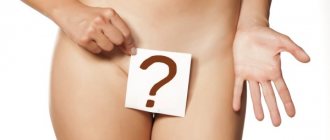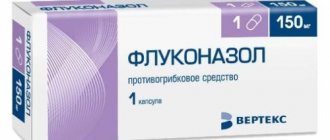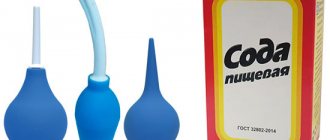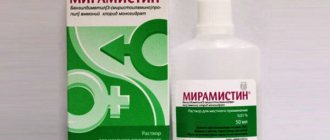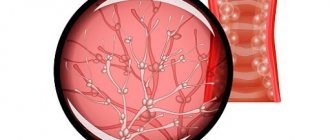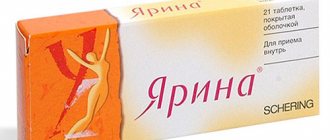Thrush is one of those diseases that is common to many women and occurs quite often, but for obvious reasons I don’t want to talk about it at all. According to statistics, more than 70 percent of women have encountered this problem at least once in their lives. This disease is caused by a fungus of the genus Candida, therefore in medicine it is called candidiasis, and one of the favorite localizations is the mucous membrane of the female genital organs.
This disease received its popular name due to a cheesy discharge and a white coating on the genitals, which are accompanied by an unpleasant, sour odor and itching. It is believed that the disease is not sexually transmitted, but many scientists and doctors claim that in 30-40% of cases the disease may indicate the presence of other conditions that appeared as a result of unprotected sexual intercourse.
For the fungus to multiply in the body, a decrease in immunity is necessary, therefore healthy women may not experience any symptoms when the pathogen enters the body. Candidiasis is treated with many drugs, but “folk” treatment is also widespread - for example, sea buckthorn oil, tea tree oil or boric acid are used to treat thrush.
Boric acid: benefits for candidiasis
Like all acids, it corrodes the least stable cell membranes, causing coagulation of intracellular protein structures and their inevitable death. This applies equally to:
- bacteria;
- viruses (due to the absence of cells, their DNA/RNA is destroyed);
- fungi;
- microorganisms;
- insects and parasitic worms (ticks, lice, helminths, but only stomach ones, since the substance requires direct contact with the pathogen);
- the simplest;
- the body's own cells (horny cells are almost insensitive, and mucosal cells are easily destroyed).
Boric acid is not an antibiotic, therefore it is equally effective in destroying healthy and infected cells. Its insecticidal properties against blood-sucking insects and worms are explained by its ability to accumulate in various types of cells, including liver/kidney/spleen parenchyma and neurons of the central nervous system. In its fight against insects and worms, the latter is especially important (it causes their paralysis and death).
In case of candidiasis, it destroys mycelium proteins and, what is especially valuable, fungal spores. For representatives of the genus Candida, this method of reproduction is atypical. But many pathogens of this type prefer it due to its reliability (the dense shell protects the spores from any negative external factors).
Benefit
Boric acid is a powder consisting of scaly crystals. Colorless. These crystals easily dissolve in liquids - in water at any temperature, as well as in alcohol. When acid is mixed with water, a slightly acidic solution is formed.
Boric acid helps against thrush because this remedy is an antiseptic, as well as drugs that disinfect inflamed areas of the skin and mucous membranes. Available in several forms - ointment, alcohol solution, dry powder, vaginal capsules.
So, this substance helps:
- inhibit the growth of pathogenic flora;
- destroy yeast fungi;
- accelerate wound healing due to astringent properties.
One of the main features of boric acid is that it destroys microorganisms by coagulating proteins that are part of the shells of pathogenic bacteria and fungi. As a result, the permeability of the shell is impaired and the microbe dies.
Contraindications and harm
Boric acid is toxic to the filter cells of the excretory organs and neurons of the peripheral and central parts of the nervous system by blocking their functions (reduces membrane permeability). Serves as an abrasive and irritant for tissues formed by granulocytes and mucous membranes. It readily accumulates, but is poorly excreted from the body due to inhibition of kidney activity - on average, within a week.
For these reasons, even under the USSR, boric acid was prohibited for use in newborn children (at least up to one year old, older - only as prescribed by a doctor), pregnant and lactating mothers. It is also not recommended to use it for more than 5 days in a row (including in therapeutic doses):
- on open wounds;
- significantly damaged skin.
The drug is strictly contraindicated for hepatitis, cholecystitis, urolithiasis, gout, nephritis of any etiology, oliguria (urinary retention), if the area of the treated area exceeds 15% of the total (no more than ¼ of the surface of the back or abdomen). Chronic overdose can result in diarrhea, nausea and vomiting, decreased volume of urine produced, and headaches. In acute and severe cases, the following are likely:
- uncontrollable vomiting and diarrhea;
- decrease in body temperature and blood pressure;
- prostration and loss of consciousness;
- erythrematous rashes;
- immersion in a coma;
- death.
A lethal dose for an adult is considered to be 5-20 g of pure (not diluted) active substance. In each individual case, it must be calculated based on the current state of the liver and kidneys and their excretory potential. With exclusively external use, taking into account contraindications, deaths have not yet been recorded - only based on the results of oral use.
The most famous case when it is recommended is the system of “treatment” of cancer according to the “people's academician” (in fact, the scientific career of its author ended upon entering graduate school at a technical university) B.V. Bolotov. This representative of alternative medicine proceeds from his own, not scientifically confirmed, ideas about malignant tumors as plant cells with an alkaline metabolism inside animal tissue with an acidic metabolism.
Accordingly, as a means of preventing and treating cancer, B.V. Bolotov recommends actively “acidifying” the body by consuming fermented products and orally taking weak aqueous solutions of acids. Increasing the acidity of all environments, including blood, should supposedly kill “alkaline” tumor cells. And hydrochloric acid, boric acid, silicon and other non-food, toxic abrasives are among the first in his system.
Side effects
With prolonged use of boric acid or exceeding the recommended dosage in the treatment of candidiasis, side effects are possible:
- vomiting, nausea, dizziness, diarrhea;
- headache;
- convulsive conditions;
- skin rash;
- peeling of the skin;
- decreased urine output;
- hair loss;
- reproductive dysfunction.
To avoid such unpleasant consequences, the course of therapy should not last longer than 3 weeks. Before treating thrush with this method, you should consult a specialist.
Quite often, when treating candidiasis, women turn to traditional medicine. In addition to douching with boric acid, douching with potassium permanganate has proven itself well. You can read more about the procedure technique in a separate article on our website.
Boric acid for thrush: application
This infectious disease is caused by a parasitic fungus of the genus Candida, which reproduces by mycelium. Immediately after infection, its symptoms manifest themselves clearly, and after the first attempt at treatment they subside; the pathogen itself is organically integrated into the composition of the healthy microflora. In the future, patients will experience periodic exacerbations each time they experience dysbacteriosis.
Thrush occurs not only in the genital tract - this fungus also feels good in the mouth. Infection of the oral cavity in adults usually occurs during oral sex, in children - while sucking milk from the breast, which the mother had previously touched with fingers contaminated with mycelium. An aqueous solution of boric acid 2-3% is one of the drugs indicated for both sexes (and children over 12 months old) against it.
Among women
The product is not intended for use and cannot be stored. The amount of active substance required for the procedure is diluted immediately before douching/washing/lottion, rinsing or instillation. To treat exacerbations of candidiasis in women, boric acid is mixed with boiled or filtered water in a proportion of 1 tbsp. l. per 1 liter of water is slightly warmer than body temperature (up to 40 0C).
Douching with boric acid for thrush is carried out according to the standard - lying on your side, with your knees drawn up to your chest, until the solution is exhausted. At the end, the remaining liquid should be wiped over the entire area of the vulva and labia majora to the thigh fold. In the acute stage, this is recommended to be done once a day, preferably at night. As the itching, burning, and volume of cheesy discharge subsides, the interval between procedures is increased to 48 and 72 hours, respectively. After the final attenuation of symptoms, 1 more “session” is recommended, but no more.
In men
Washing for representatives of the stronger sex requires dissolving 1 tsp. active ingredient in 50 ml of potable water at the same temperature as for women. In the process, you need to pay special attention to the folds of the foreskin and the head of the penis under it (along with the entrance to the urethra). The entire pubic area should also be treated, up to the thigh folds and behind the testicles, towards the anus. The length of the course and the frequency of procedures also depend on the severity of the exacerbation. Use of the product more than once a day is not recommended; less often, on the contrary, it is indicated. It is very good if the therapy does not take more than a week.
In children
Up to 12 months it is contraindicated, in the future it is allowed for use as prescribed by a pediatrician. They are prohibited from rinsing their mouths until the age of 5 or any age when the child learns to spit out the liquid at the request of the parents instead of swallowing. It is dissolved in 0.5 g per 30 ml of warm water and used externally - for rubbing (including diaper rash) and shallow douching (only for girls), according to a schedule every other day, for no longer than 5 days. The interval between courses should be at least 14 days.
The effectiveness of douching for thrush: how to do it correctly?
Almost all female representatives are familiar with the definition of candidiasis. This hated disease torments with itching, a fishy smell, and sometimes discharge. What is the reason for its appearance in women? After all, even with 100% hygiene and the use of expensive imported medications, signs of thrush appear again.
Why does this happen? First of all, you need to have a good understanding of what signals the appearance of candidiasis. Knowing the initial signs and measures to prevent the disease will help you recover faster and more reliably protect yourself from it.
Thrush: what is it and why does it appear?
Thrush is an infection of the mucous membranes of the body by fungi of the genus Candida. It acquired this symbolic name because of the most striking symptom - a cheesy white discharge; in addition, the disease is accompanied by itching, redness and a foul odor. In women, candidiasis usually affects the vagina.
What is the nature of the disease? Fungi of the genus Candida are permanent residents of the human body. They do not enter the body through airborne droplets or through household items or through scratches. These microorganisms are always found on the mucous membranes of the vagina, intestines or mouth. They live in an opportunistic environment. Such a neighborhood is harmless as long as there is no conflict between bacteria.
Healthy microflora and strong immunity give the body strength to fight the growth of fungi. In case of a failure of the immune system, thrush is almost 100%.
A warm, humid place is considered a good environment for Candida fungi. The vagina is an excellent place for such bacteria to exist.
There are two ways how mushrooms can enter the body:
Table - Causes of thrush
| Method of infection | Interior | Weak immunity |
| Taking antibiotics | ||
| Infections | ||
| Hormone-based medications | ||
| Climate change | ||
| Oncology | ||
| Diabetes mellitus or thyroid disease | ||
| Psychological shocks | ||
| External | Infected sexual partner | |
| Incorrect hygiene: you need to wash from front to back | ||
| Through household items: dirty towel, soap, panty liners | ||
| Underwear that is too tight and doesn't breathe | ||
| Allergy to soap, sanitary pads, synthetics (underwear) |
Douching for thrush. How to douche correctly?
Douching means washing the vaginal walls with a medicinal composition. The procedure is done to get rid of pathogenic microbes in a specific cavity, to cure gynecological ailments and for prevention. This folk method is popular. Copes well with the problem.
The most common compositions for douching for thrush:
- Salt.
- Iodine.
- Chlorophyllipt solution.
- Celandine.
- Boric acid.
- Fermented milk products: kefir, whey.
- Rotokan.
Success in the fight against a disease always depends on the implementation of all procedures. Proper douching reduces the bad effect on inflamed mucous membranes.
Sequence of douching for thrush:
- wash the genitals and perineum in warm water and baby soap;
- temperature range of the treatment composition is 36-40 0 C;
- take the solution into a mug (Esmarch mug) or into a syringe;
- position - lying on blue, knees bent and tucked;
- moisten the tip of the item being used with oil;
- there should be no air in the mug or syringe;
- pour the solution into the vagina;
- irrigate the mucous membrane and perineum with the medicinal composition.
Douching with salt
The acid-base balance of the vagina will help restore salt. This solution will wash away the fungi and help prepare the vagina for therapy with suppositories and tablets. This will also relieve itching and discharge.
The recipe for preparing the composition is simple. The ingredients can be found in every home. You need a tablespoon of salt, 1 liter of boiled water and a pear. Dissolve the salt in boiling water that has cooled to 370 C. Dissolve completely! The nose of the pear must be boiled before manipulation. The rest should be disinfected.
Sea salt is also suitable for douching for thrush. The proportions will change. In this option, put 1.5 tbsp in boiled water. spoons of salt. Keep warm for some time. Sue. The solution must be warm. Can be used once or twice a day.
Sea salt contains iodine. It additionally disinfects the mucous membrane. A decoction of chamomile or oak bark will enhance the effect of salt on microorganisms. Contributes to the speedy renewal of tissues.
Douching with iodine for thrush
Iodine disinfects, stops inflammation, reduces swelling. Before douching, it must be diluted with water. Otherwise there will be a burn. Distilled water. If desired, you can add soda. To combat fungus.
The solution is prepared as follows:
- Boil 1 liter of water in a container.
- Put 30 gr. salt.
- After boiling, add 5 g. iodine and soda.
- The solution should have a temperature of 360 C.
- Apply the liquid for seven days, twice a day.
Douching with chlorophyllipt
Eucalyptus leaves contain chlorophylls. These substances inhibit bacteria and eliminate inflammation. They produce different chlorophyllipt: oil solution, alcohol solution, spray, pills.
Alcohol chlorophyllipt is prescribed when there are infections in the vagina. To do this, take a tablespoon of a 1% solution and add it to 1 liter of boiled water.
Note! Alcohol solutions are not used in their pure form. The consequence will be serious burns of the mucous membranes.
The doctor treats the cervix for erosion with 2% chlorophyllipt in oil form. Using a cotton swab.
The drug is not prescribed if a person is allergic to the plant. Or he can't stand it.
Treatment of thrush with celandine
Celandine is a universal drug. It is in demand for various diseases, and thrush is no exception.
The properties of this herb are aimed at eliminating putrefactive processes, reducing and healing inflammation, and having an antibacterial effect. This drug penetrates the cells of the body, activates the immune system and fights the disease.
Important! The juice or infusion of celandine must be diluted. The plant is poisonous.
Infusion of celandine is recognized as the best way to treat thrush. It is not difficult to prepare the required composition: you need to pour a couple of tablespoons of herb with one liter of hot water. Let stand for three to four hours. The infusion can be used.
Before use, the liquid must be warmed to room temperature. Douche for a week. Twice a day. During this time, the signs of thrush go away. In order not to avoid a relapse, it is worth repeating the steps for another seven days.
Douching with boric acid
For douching for thrush, boric acid is prescribed in powder form. Then you need to dilute it in water.
Boric acid is used in combination with other medications in the fight against thrush. To prepare the solution you need 1 tsp. dilute acids in 1 liter of boiled water. Douche for seven days. Two to three times a day.
Douching with serum for thrush
The acidophilus bacterium can suppress the growth of fungal lesions using lactic acid.
The serum contains acids that can cope with inflammation, act as an antiseptic, and a powerful weapon against fungi.
Kefir douching directly directs lactic acid bacteria to the cause of fungal infection. This method is simple. It is enough to heat 250 gr. kefir to 370 C. Heat in a water bath.
Goat's milk whey is considered better. The duration of treatment is a week. Irrigate the vagina twice a day: morning, evening.
Douching with rotokan
Rotocan is an alcohol solution. It contains calendula flowers, yarrow, chamomile flowers and ethyl alcohol. This remedy can relieve spasms, affect inflammation, relieve pain, and stimulate regeneration.
Doctors prescribe rotokan extremely rarely. Typical environment of use is dentistry. Women who have tried it recommend it as a good remedy for itching, dryness, and discharge. It cannot be used in its pure form. It must be diluted in boiled water in the ratio recommended by the doctor.
Source: https://kandidoz.pro/sprintsevanie.html
Reviews
In general, boric acid is no more dangerous than any other antimycotic or antibiotic, especially a potent one belonging to the latest generation. Reviews of its effectiveness remain positive even after repeated use due to the lack of addiction.
Egor, 21 years old: “After various contacts that raise questions, I only use this. All medications have side effects, only antifungal ointments need to be changed every couple of uses. And disinfect with boric acid for a couple of days at least for the rest of your life.”
Leticia, 35 years old: “It’s a pity that I don’t even know who “rewarded” me with thrush. Or maybe it’s for the best: if I found out, I’d kill her! Once a month during PMS it is consistently “updated”. But boric acid always saves the day, and for some reason the critical days themselves pass easier after it.”
Olesya, 46 years old: “In my youth, candidiasis manifested itself very rarely. And now the doctor says that age, the composition of the microflora is changing... So, what’s most offensive, I can’t use boron “talker” and other simple antiseptics! It's really painful to dry, and it only makes it itch worse. I use Zalain, there is nothing to do.”
Thrush: what is it and why does it appear?
Thrush is an infection of the mucous membranes of the body by fungi of the genus Candida. It acquired this symbolic name because of the most striking symptom - a cheesy white discharge; in addition, the disease is accompanied by itching, redness and a foul odor. In women, candidiasis usually affects the vagina.
What is the nature of the disease? Fungi of the genus Candida are permanent residents of the human body. They do not enter the body through airborne droplets or through household items or through scratches. These microorganisms are always found on the mucous membranes of the vagina, intestines or mouth. They live in an opportunistic environment. Such a neighborhood is harmless as long as there is no conflict between bacteria.
Administration of capsules
The acid will help normalize the pH of the vagina, which is especially important for vaginal candidiasis. After using this product, an optimal vaginal environment is created: it is this that inhibits the further spread of fungal microflora.
However, I recently encountered thrush during pregnancy. The situation is delicate, you understand. and not just any remedy will do (especially the one I mentioned above).
Boric acid is contraindicated for use in children, pregnant or lactating women, and those with kidney disease. If peeling of the skin, headache, irritability or discomfort occurs, the drug should be discarded or the concentration of the solution should be reduced.
42 rubles


